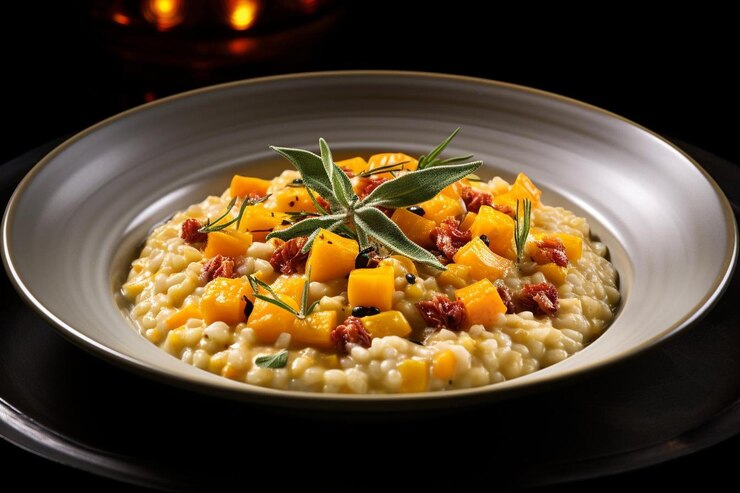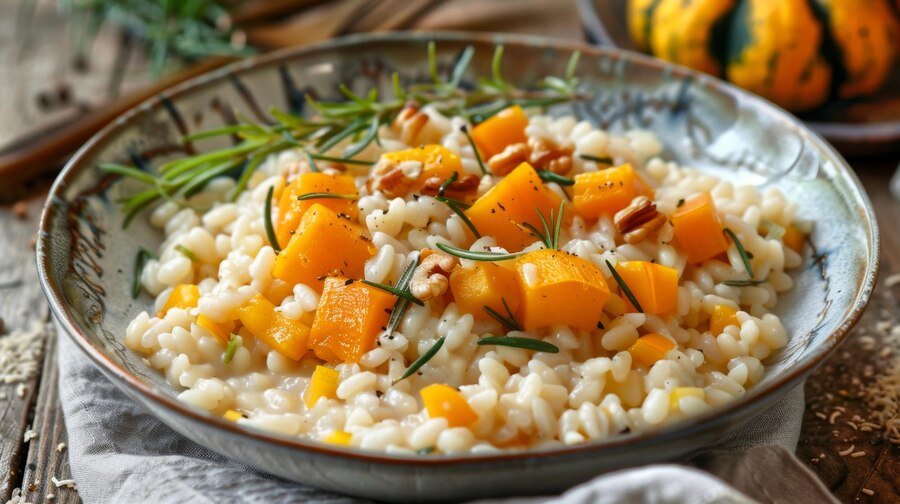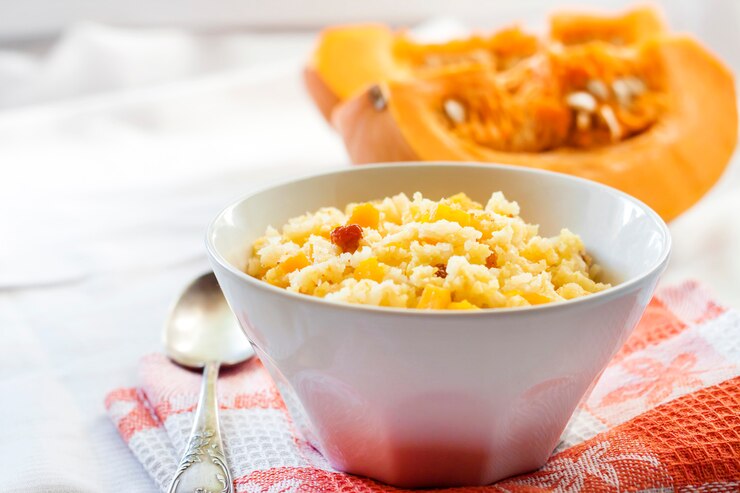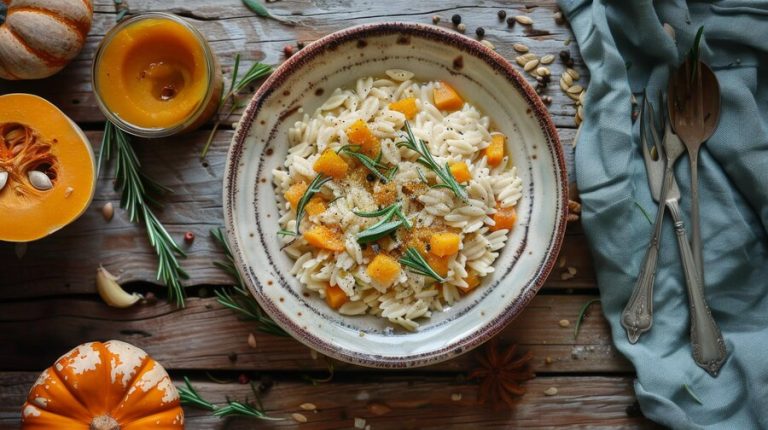Looking for a romantic and delicious dish to impress your Valentine? Skip the crowded restaurants and create a cozy night in with a stunning, yet surprisingly easy, butternut squash risotto. This recipe delivers all the flavor without all the fuss, making it the perfect centerpiece for your Valentine’s Day celebration.
From classic versions reminiscent of Jamie Oliver’s comforting style to modern twists inspired by culinary giants like Gordon Ramsay, the possibilities are endless. Whether you’re searching for a simple weeknight meal or a show-stopping dish like those featured in the NYT, BBC, or even Ina Garten’s repertoire, this easy butternut squash risotto recipe will guide you through creating a creamy, flavorful masterpiece. Read on to discover the secrets to a perfect roasted butternut squash risotto, including tips for vegan adaptations, and make this Valentine’s Day truly special.
Ingredients:
- 1 medium butternut squash, peeled, seeded, and cubed
- 1 tablespoon olive oil
- 1 small onion, finely chopped
- 2 cloves garlic, minced
- 1 ½ cups Arborio rice
- ½ cup dry white wine (optional, or use vegetable broth)
- 6 cups hot vegetable broth
- ½ cup nutritional yeast
- ¼ cup vegan butter
- 2 tablespoons fresh sage, chopped
- Salt and freshly ground black pepper to taste
- Vegan Parmesan cheese (optional, for serving)
Prep Time: 20 minutes
Cook Time: 30 minutes
Total Time: 50 minutes
Serving Size: 4-6 servings
Estimated Cost (US Market): $15-$25 (This is a rough estimate and can vary based on location, seasonality, and specific brands. Buying in bulk or using less expensive alternatives can lower the cost.)
Step 1: Roast the Butternut Squash
Preheat your oven to 400°F (200°C). Toss the cubed butternut squash with olive oil, salt, and pepper. Spread it on a baking sheet and roast for 20-25 minutes, or until tender and slightly caramelized.
Step 2: Sauté the Aromatics
While the squash is roasting, heat the vegan butter in a large pot over medium heat. Add the chopped onion and cook until softened, about 5 minutes. Then, add the minced garlic and cook for another minute until fragrant.
Step 3: Toast the Rice
Add the Arborio rice to the pot and toast it for 2-3 minutes, stirring constantly, until the grains become translucent. This step is crucial for achieving the creamy texture of risotto.
Step 4: Deglaze the Pot
If using, pour in the white wine (or ½ cup of the hot vegetable broth) and stir until it’s completely absorbed by the rice. This will add depth of flavor to the risotto.
Step 5: Add the Broth
Begin adding the hot vegetable broth, one cup at a time, to the rice. Stir constantly until each cup is almost completely absorbed before adding the next. This process should take about 20-25 minutes.
Step 6: Stir in the Squash and Flavorings
Once the rice is cooked al dente (tender but with a slight bite), stir in the roasted butternut squash, nutritional yeast, and chopped sage. Season with salt and pepper to taste.
Step 7: Finish with Vegan Butter
Remove the pot from the heat and stir in the remaining vegan butter. This will add richness and creaminess to the risotto.
Step 8: Serve
Serve the butternut squash risotto immediately, garnished with vegan Parmesan cheese, if desired. This dish is perfect for a romantic Valentine’s Day dinner!

Storage and Reheating Instructions for Vegan Butternut Squash Risotto
Storing Leftovers
Allow the risotto to cool completely to room temperature before storing. This helps prevent condensation, which can lead to bacterial growth. Once cooled, transfer the leftover risotto to an airtight container. You can also portion it out into individual containers for easy reheating.
Stored properly in the refrigerator, leftover vegan butternut squash risotto will generally last for 3-4 days. It’s always best to use your best judgment and check for any signs of spoilage before consuming (e.g., off-putting smell, unusual texture).
Reheating Methods:
Reheating risotto can be a little tricky, as it tends to thicken as it cools. The key is to add a little bit of liquid to restore its creamy consistency. Here are a few methods:
Stovetop: This is the preferred method for the best texture. Place the risotto in a saucepan over medium-low heat. Add a splash of vegetable broth or water (about 1-2 tablespoons per serving) and stir gently. Heat until the risotto is warmed through, stirring frequently to prevent sticking. You may need to add a little more liquid if it seems too dry.
Microwave: While quicker, the microwave can sometimes make the risotto a bit uneven in texture. Place the risotto in a microwave-safe dish and add a tablespoon or two of vegetable broth or water per serving. Cover and microwave on medium heat for 1-2 minutes, or until heated through. Stir halfway through. Be careful not to overheat, as this can make the rice dry and rubbery.
Oven: For larger quantities, the oven can be a good option. Preheat your oven to 350°F (175°C). Place the risotto in an oven-safe dish, add a little vegetable broth or water, and cover tightly with foil. Heat for 15-20 minutes, or until warmed through.
Tips for Best Taste:
- Don’t Overheat: Overheating the risotto can cause it to become dry and mushy. Heat it gently and just until it’s warmed through.
- Add Liquid: Adding a little vegetable broth or water is crucial for restoring the creamy consistency of the risotto.
- Stir Frequently: Stirring helps to distribute the heat evenly and prevent sticking.
- Taste and Adjust: After reheating, taste the risotto and adjust the seasoning as needed. You may want to add a little more salt, pepper, or fresh herbs.
By following these storage and reheating instructions, you can enjoy your delicious vegan butternut squash risotto even after the initial meal!

Nutritional Information (Approximate Values)
It’s important to note that these values are estimates and can vary based on specific ingredient brands, portion sizes, and preparation methods. Nutritional information for vegan versions can differ from non-vegan versions due to ingredient substitutions. This information is for guidance only and should not be considered medical advice.
| Nutrient | Amount per Serving (Approx. 1 cup) | % Daily Value* |
| Calories | 300-350 | ~15-18% |
| Total Fat | 10-15g | ~15-20% |
| Saturated Fat | 2-3g | ~10-15% |
| Trans Fat | 0g | 0% |
| Cholesterol | 0mg | 0% |
| Sodium | 400-500mg | ~17-21% |
| Total Carbohydrate | 50-60g | ~17-20% |
| Dietary Fiber | 5-7g | ~20-28% |
| Total Sugars | 10-15g | |
| Added Sugars | 0g | 0% |
| Protein | 8-10g | ~16-20% |
| Vitamin D | 0mcg | 0% |
| Calcium | 50-75mg | ~6-8% |
| Iron | 2-3mg | ~11-17% |
| Potassium | 400-500mg | ~8-11% |
Percent Daily Values are based on a 2,000 calorie diet.
Important Considerations:
- Serving Size: The nutritional values above are estimates for approximately one cup of risotto. Adjustments should be made for different serving sizes.
- Ingredient Variations: The type of vegan butter, nutritional yeast, and vegetable broth used can impact the nutritional content. Always check the labels of your specific ingredients.
- Sodium Content: Pay attention to the sodium content of your vegetable broth, as some brands can be high in sodium. Consider using low-sodium options.
- Macronutrient Balance: This dish provides a good balance of carbohydrates, protein, and healthy fats.
- Fiber: Butternut squash and the inclusion of whole grain rice contribute to the fiber content.
This table provides a general overview. For the most accurate nutritional information, it’s recommended to input the specific ingredients and quantities used in your recipe into a nutrition calculator.
Dietary Information
This recipe for Vegan Butternut Squash Risotto is suitable for vegans as it uses plant-based ingredients exclusively. It is also naturally dairy-free and egg-free.
- Gluten-Free: This recipe can be made gluten-free, but it’s crucial to ensure that the vegetable broth you use is certified gluten-free. While Arborio rice itself is gluten-free, some brands of broth may contain gluten as a thickening agent. Always check the label.
- Keto: This recipe is not keto-friendly. It is high in carbohydrates due to the rice and butternut squash. A ketogenic diet typically restricts carbohydrate intake significantly.
- Other Allergies: While this recipe is free of dairy and eggs, always double-check the labels of all ingredients (especially vegan butter, nutritional yeast, and vegetable broth) if you have other allergies (e.g., soy, nuts). Some vegan substitutes may contain common allergens.
It’s always recommended to double-check all ingredient labels and consult with a healthcare professional or registered dietitian if you have specific dietary concerns or allergies.

History of Butternut Squash Risotto
Butternut squash risotto, while a relatively modern culinary creation, draws upon the long histories of both risotto and the cultivation of butternut squash. Risotto, a creamy rice dish, has its roots in Northern Italy, where short-grain rice varieties like Arborio have been grown for centuries.
The technique of slowly adding broth to toasted rice, stirring constantly to release starches and create a creamy texture, is a hallmark of traditional risotto preparation. Butternut squash, a type of winter squash native to the Americas, was domesticated thousands of years ago and became a staple in Indigenous diets.
Its sweet, nutty flavor and smooth texture make it a natural complement to the creamy richness of risotto. While the exact origins of butternut squash risotto are unclear, it likely emerged as chefs and home cooks began experimenting with combining seasonal ingredients and adapting classic dishes.
The pairing of butternut squash and risotto offers a delightful balance of sweet and savory, making it a popular choice for autumnal and winter meals, especially during holidays or special occasions like Valentine’s Day. The dish’s versatility also allows for variations with other ingredients like herbs, cheeses (both dairy and vegan), and proteins, further contributing to its widespread appeal.
What goes with butternut squash risotto?
Butternut squash risotto, with its creamy texture and sweet, savory flavor profile, pairs well with a variety of complementary dishes. A simple green salad with a light vinaigrette can provide a refreshing contrast to the richness of the risotto. Roasted vegetables like Brussels sprouts, asparagus, or root vegetables enhance the autumnal flavors and add textural interest.
For a heartier meal, a vegan option, try some toasted nuts or seeds for added protein and crunch. A sprinkle of Parmesan cheese (or a vegan alternative) can add a salty, umami note. Finally, a crisp white wine, such as Pinot Grigio or Sauvignon Blanc, or a light-bodied red wine like Pinot Noir, can beautifully complement the flavors of the dish.
What does cooked butternut squash taste like?
Cooked butternut squash offers a subtly sweet and nutty flavor, often described as similar to a blend of sweet potato and pumpkin, but with a more delicate and buttery nuance. Its texture, when roasted or pureed, becomes smooth and creamy, almost melting in your mouth. The sweetness intensifies as it cooks, and a slight caramelization can develop on the surface, adding depth to its taste.
Unlike some other winter squashes, butternut squash isn’t overly sweet, making it versatile for both savory and sweet preparations. This balanced flavor profile makes it a popular ingredient in dishes ranging from soups and risottos to pies and muffins.
Final Thoughts
This easy vegan butternut squash risotto is more than just a delicious meal; it’s an experience. From the vibrant colors of the roasted squash to the creamy, comforting texture of the risotto, every element combines to create a dish that’s perfect for a special occasion like Valentine’s Day, or simply a cozy night in.
The best part? It’s surprisingly simple to make, even for novice cooks. With a few simple ingredients and a little patience, you can create a restaurant-quality meal that’s sure to impress your loved ones (or yourself!). Whether you’re a seasoned vegan or just looking to explore plant-based cuisine, this recipe offers a delightful and satisfying way to celebrate the flavors of the season. So, gather your ingredients, put on some music, and enjoy the process of creating this heartwarming and romantic dish. You might just find yourself with a new favorite recipe!









